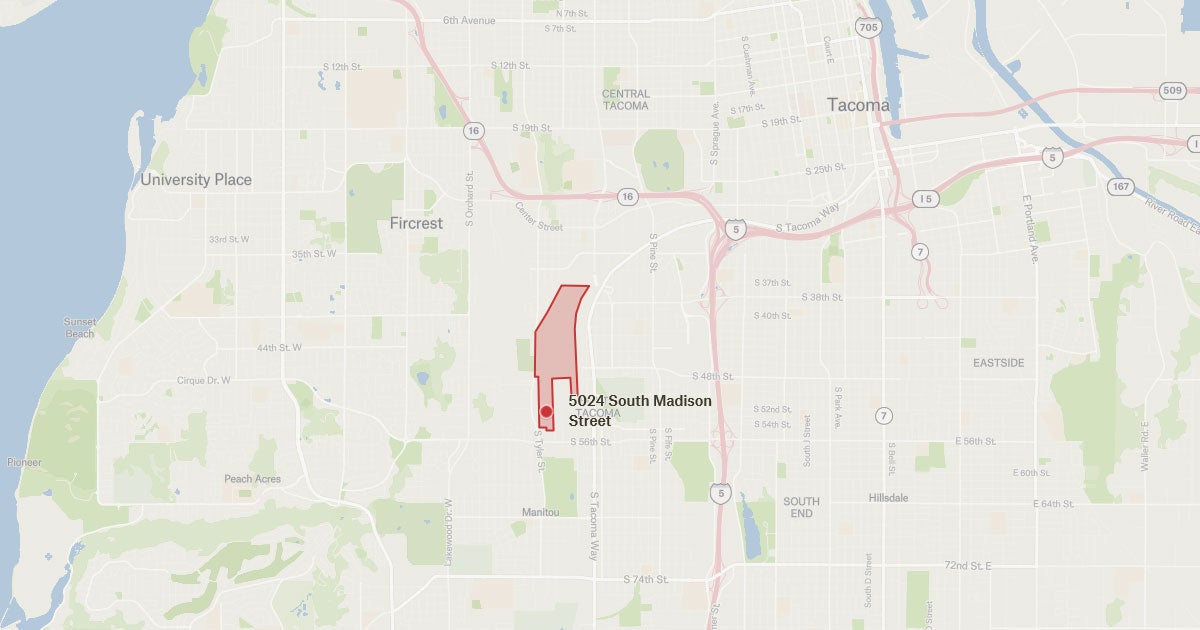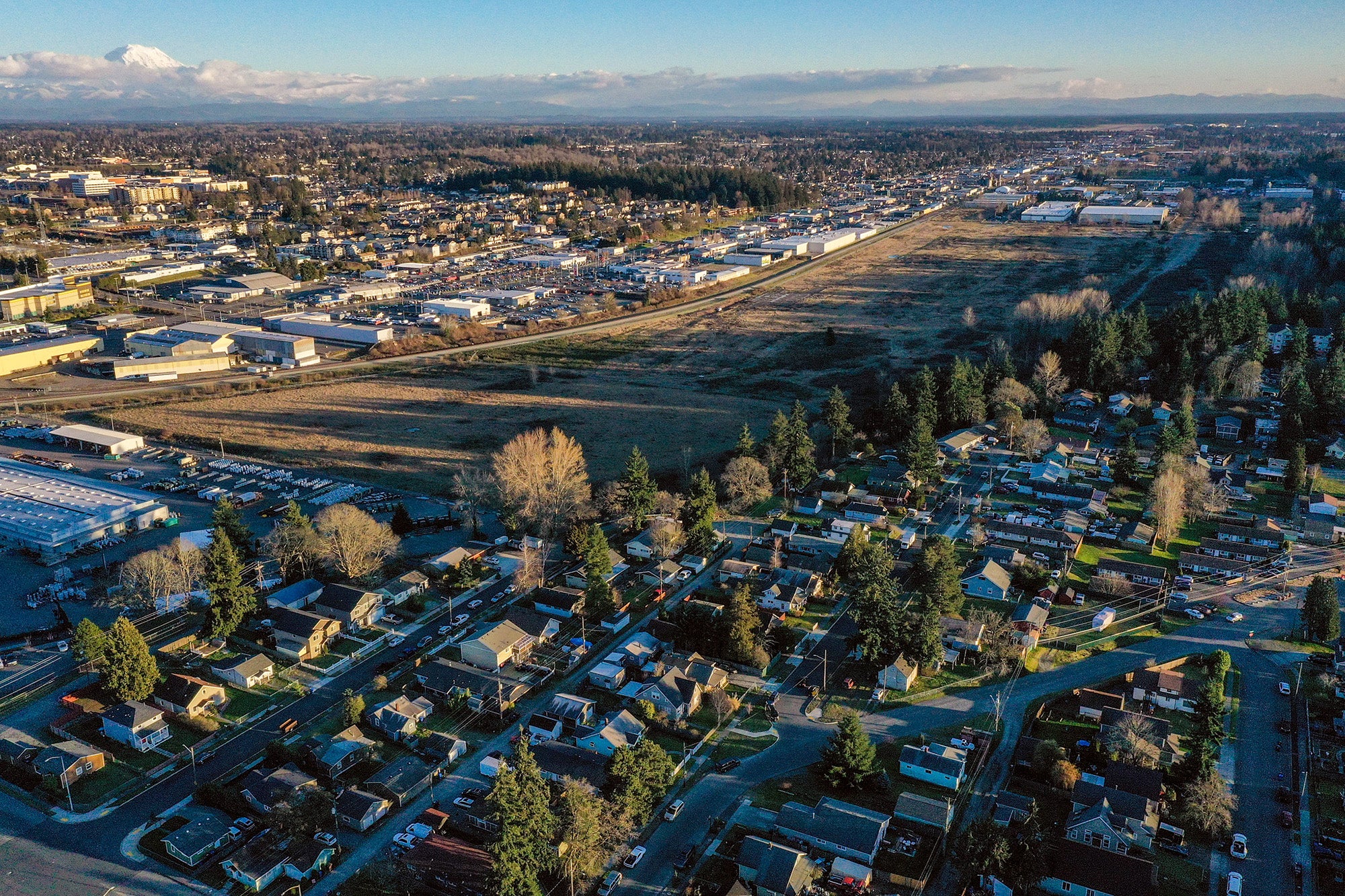October 6, 2023
What You Should Know About the Bridge Industrial South Tacoma Warehouse Project

Sign-On Letter Calling for a Health Impact Assessment: Add your voice to community voices calling for a comprehensive study of the cumulative health impacts of a proposed mega-warehouse and other sources of pollution on South Tacoma!
Where is the Warehouse Project Located?
The address for the Bridge Industrial South Tacoma Warehouse Project is 5024 S. Madison St., Tacoma, WA.
The warehouse project site encompasses a large chunk of undeveloped land south of S. 36th St., north of S. 56th St., east of S. Tyler St., and west of the railroad tracks.
The project site is:
- 147 acres of undeveloped space containing wetlands, trees, and green space
- Located on top of the South Tacoma Aquifer, a major source of drinking water for Tacoma
- A “Superfund” site, with contaminated soil currently buried on the site
About the Proposed Project
- 2.5 million square feet of warehouses — comparable in size to 43 football fields
- Being marketed as a potential distribution center for fulfilling online orders, given proximity to I-5 and the Port of Tacoma
- Would pave over undeveloped land to create 20 acres of parking lots to park 1,436 vehicles
- Developer: Bridge Industrial, a Chicago-based developer with a growing presence in Washington
What’s Happening Now?
Despite the hazards of the warehouse project, the City of Tacoma says the project doesn’t need a full accounting of its environmental impacts and approved a land use permit for the warehouse.
In May 2023, Earthjustice appealed that decision on behalf of community groups 350 Tacoma and the South Tacoma Neighborhood Council.
The City of Tacoma Hearing Examiner heard the appeal at a trial in July and August 2023. He sided with the City and the developer and ruled that no Environmental Impact Statement was required.
Advocates for a full environmental analysis of the warehouse project continue to raise community awareness.
Washington’s State Environmental Policy Act requires an Environmental Impact Statement (EIS) for any projects that will probably cause significant environmental harms. The City should order an EIS to analyze all of the project’s environmental impacts and give residents a fully informed opportunity to weigh in on how the project will impact their lives and livelihoods.
Key Documents
- City of Tacoma Hearing Examiner Decision (filed Oct. 5, 2023)
- Posthearing Brief of Appellants (filed Aug. 28, 2023)
- Prehearing Brief of Appellants (filed July 18, 2023)
- Letter to City of Tacoma addressing the question of the City’s authority to conduct a Health Impact Assessment (filed May 17, 2023)
- Notice of Appeal (filed May 5, 2023)
- Public Comment on Proposed Permit and MDNS for LU21-0125 (filed Apr. 21, 2022)
Likely Project Impacts
- Increased air pollution and traffic, including thousands of polluting diesel trucks. Diesel trucks are one of the largest sources of pollutants that cause asthma, heart disease, weakened immune systems and susceptibility to COVID-19, cancer, and premature death. People who live near diesel pollution are most at risk: long-term exposure to diesel pollution is even more deadly than short-term exposure.
- Thwarted progress on climate goals. Greenhouse gas (GHG) emissions from gas- and diesel-powered vehicles account for close to half of Washington’s total climate pollution. While other sources of GHGs have held steady or been reduced, transportation emissions have been increasing in Washington. A project that generates thousands of new trips every day from gas- and diesel-powered vehicles is a huge step in the wrong direction. The developer is also proposing to install new gas hook-ups for gas-powered generators.
- Harm to Tacoma’s aquifer. Paving over the aquifer will change the rate at which the aquifer is “recharged” and could reduce the water level in the aquifer and cause the aquifer to pull in nearby contaminated groundwater. It could leave Tacoma with insufficient water supply or a contaminated water supply.
- Potential flooding. Replacing open land that helps absorb stormwater with impervious surfaces will likely lead to stormwater system backups and floods, particularly if the stormwater system is not equipped to handle increased storm intensity and frequency caused by climate change. If the developer does not capture and adequately treat all stormwater from the site, groundwater contamination may occur.
- Noise pollution. Loud, sustained noise is not just unpleasant and potentially harmful to your hearing, it can also cause, and add to, heart problems, stress, anxiety, and depression.
- Hotter neighborhood temperatures. Building on top of previously undeveloped land could make the neighborhood hotter because buildings and parking lots absorb and re-emit the sun’s heat more than natural landscapes. A high concentration of manmade structures can create a “heat desert” with higher temperatures than surrounding areas with more greenery.
- Worsening environmental injustice. Tacoma’s Equity Map rates the project area “Low” for Equity, “Low” for Environmental Health, and “Very Low” for Livability. The area has more residents of color than 80-95% of the state. These residents already have a greater risk of cancer from toxic air pollution than 90-95% of the state and a lower life expectancy than 95-100% of the state. The project will exacerbate this inequity.

Across the country, a boom in e-commerce is driving demand for warehouse space, and these warehouses are often built in communities already overburdened with pollution. Many of these communities are fighting back. In Southern California, Earthjustice worked alongside environmental justice and conservation groups to reach a settlement that will mitigate the harm of a warehouse the size of three Central Parks, and in New York, we are working to strengthen zoning regulations for last-mile warehouses.
Established in 1987, Earthjustice's Northwest Regional Office has been at the forefront of many of the most significant legal decisions safeguarding the Pacific Northwest’s imperiled species, ancient forests, and waterways.